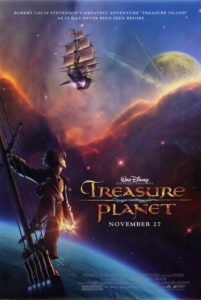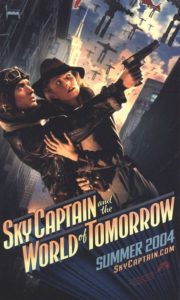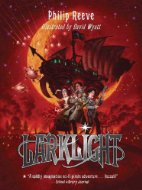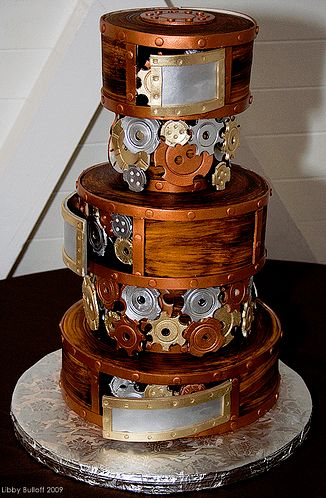The Rise Of Steampunk
That was me last week, seconds after I had name-dropped a certain term while interviewing someone for my day job. She was a bed-and-breakfast owner; I was your mild-mannered reporter for a “great” “metropolitan” weekly. And based on her expressed wishes to have more of an antique feel to the place, to match its hundred-year antiquity, I mentioned that things such as vintage fashion and design are actually growing popular because of “steampunk.”
Oh, good one, I thought, drop a geek-term and make her have to smile and nod.
But actually she agreed, saying her daughter was so into that type of thing, especially with long dresses. So not only did I learn another lesson about arrogantly thinking “regular” folks don’t know about that kind of stuff, I thought to ensure I knew the term’s definition myself.
Initial research seems to confirm my previous impression: steampunk actually doesn’t constitute a great portion of popular literature or movies so far. From what I’ve seen and read, it is more of a flavor. Science-fiction-meets-Victorian-alternate-histories themes, often with pipes, gears, valves and little circular dials, are being integrated into all kinds of designs for instruments, custom computer-screen casing, toys, even decorative cakes.
 By contrast, cursory searches for “steampunk” fiction don’t turn up a lot, at least not yet: a fiction tribute or two to Jules Verne, a couple of early-hundreds Disney films that didn’t do too well (Atlantis and Treasure Planet, the latter of which I’ve seen and still enjoy), some graphic novels, the 2009 film Sherlock Holmes, or the upcoming sequel series to Avatar: The Last Airbender, called The Legend of Korra. (Biased moment: hurrah for more animated Avatar! and may M. Night Shyamalan repent of his sins and find inner peace, away from studio funding).
By contrast, cursory searches for “steampunk” fiction don’t turn up a lot, at least not yet: a fiction tribute or two to Jules Verne, a couple of early-hundreds Disney films that didn’t do too well (Atlantis and Treasure Planet, the latter of which I’ve seen and still enjoy), some graphic novels, the 2009 film Sherlock Holmes, or the upcoming sequel series to Avatar: The Last Airbender, called The Legend of Korra. (Biased moment: hurrah for more animated Avatar! and may M. Night Shyamalan repent of his sins and find inner peace, away from studio funding).
My first exposure to “steampunk” came from 2002’s Treasure Planet and one of the first all-in-front-of-bluescreen films, 2005’s Sky Captain and the World of Tomorrow. I’m still not quite sure why I like them so much, or the “steampunk” idea. And that becomes more confusing when one takes into account that these films have devoted fans, but bombed in theaters.
 Some stories also necessitate the quotes around the term steampunk, because technically they’re not set in some alternate-history or even alternate-universe version of this world with steam-powered devices. Better terms, I suggest, might be retro-fantasy, or historical fantasy.
Some stories also necessitate the quotes around the term steampunk, because technically they’re not set in some alternate-history or even alternate-universe version of this world with steam-powered devices. Better terms, I suggest, might be retro-fantasy, or historical fantasy.
Yet it seems steampunk is a catch-all description for many kinds of stories, or designs based on implicit ideas, that suggest: what if such-and-such event occurred in a world/our history, or this invention caught on more than it actually did, or mankind never had this or that war, or helium dirigibles revolutionized the world instead of airplanes, or silicon chips were never developed?
A waterbender-powered submarine from "Avatar: The Last Airbender"
You might think of revisions or supplements to that definition. And of course, steampunk concepts aren’t just applied to alternate-history stories set in this world. Howl’s Moving Castle, my wife tells me, included a fantasy world with steampunk elements. The American-created-so-please-don’t-mock-me-for-watching-a-supposedly-anime series, Avatar: The Last Airbender, incorporated all kinds of fantastic retro-fantasy concepts, especially in the Fire Nation and the machines used (‘ware spoilers!) to attack it — which gets really fun when you have machines powered by the magic-like abilities of earth-, fire- or water-controlling people called “benders.”
Two questions, for which you might know the answers better than me:
Have Christians caught up to steampunk?

"Larklight" (Philip Reeve, 2006), the first of three fun stories set in alternate-history Victorian England, Earth and space
As has been firmly established by the wisdom of our Speculative-Faith comment sages (may they be blessed), Christians tend to be about two years behind cultural trends. (Thank God our best and brightest somehow missed emulating the “Spice Girls,” but some of us are still stuck on “Fear Factor”-themed youth-groupie stunts.) That means that if steampunk is popular now among readers of visionary fiction, it might be a while before publishers catch up. But have you seen retro-fantasy styles or themes in Christian visionary novels, for youth readers or others?
Why is steampunk growing in popularity?
My best theory probably did make my bed-and-breakfast acquaintance smile and nod politely.
I ventured the idea that, at least clothing-wise, as fashions just keep going up to here and down to there, there just isn’t much left to strip off. Naturally the culture could swing the other way: back in time, to “vintage” styles, maybe a little tricked out to add a fantasy edge, but as a subtle kind of “rebellion” against the notion that sees new and modern as always better.
If that’s nearly true, I may have found an actual theological reason to enjoy steampunk. Often the past is better, and history is fantastic, whether it’s real or with what-if-Jules-Verne’s-world-actually-happened? notions. It’s also fun, and I’m still trying to discern why. Want to help?










































There’s more Steampunk out there in the comic tradition, if you know where to look, though you do have to sometimes handle it with long tongs:
I’m thinking of Girl Genius (http://girlgeniusonline.com), which mostly has a good storyline and fairly decently clad characters–except when they’re not–(warning here)
There’s also a Steampunk chapter-by-chapter novel at: http://airships.paulgazis.com, where usually if there’s a problem, it’s the art in the advertisements on the sidebar, as it sadly seems to be this morning. If you can ignore that, the story usually has quite a lot to recommend it.
I’m not sure if Ray Gun Revival (http://raygunrevival.com) would qualify in some universe as “Steampunk,” but I suspect not. They are, however, starting up their online magazine again, come February. I have no trouble recommending their work without qualifiers.
I was browsing through the “looking for section” of a small publishing company (always looking to see who might take fantasy) and found they were actually looking for steampunk romance. Since this company predominantly does romance, I couldn’t believe they actually knew the word steampunk! lol
Then in the last week, steampunk has come up twice in the digital worlds I’m a part of. Which makes me think I should bring that steampunk that’s been percolating in the back of my head forward and consider it more seriously (or retro fantasy as you call it… it has fantasy themes to it).
Not only is steampunk a big thinng in webcomics but it has been a big thing in YA fiction (secular), probably since Manga/Anime became popular in the US (I would say the last 10 years). Manga and anime often have steampunk themes. For instance Studio Ghibli, who did the movie version of Howl’s Moving Castle has done several others as have several other anime studios. In YA fiction I can list at least 10 books off the top of my head from the last year that are steampunk (and really good reading).
As to why it is becoming more popular? I would say several factors.
First we in the fantasy loving community, who devoured all the Tolkien, Lloyd Alexander, Terry Brooks, Piers Anthony, and all the other fantasy writers out there are burned out. Castles and armor are lovely but too much is enough. Now here is a setting that we know and recognize where we can put new things and have new things happening so Victorian London is the new Medieval.
It appeals to the imagination. What if you could use steam and gears instead of electricity? What would it look like? How would that change life? What if the Hindenburg hadn’t exploded and dirigibles filled the sky instead of airplanes? What if there was just a little magic that made all these things work (there would have to be magic to make them really work since changing the laws of physics enters entirely new ground and takes it out of fantasy and into sci-fi.)
And of course there are the clothes, which are stylized and beautiful and with their whale bones and structure fit very well into the steampunk ideal. And not just the clothes, but the mechanics– we are tired of ipods and everything all modern, crisp, and clean and utilitarian. Steampunk mechanics are beautiful, and interesting, and have all sorts of unnecessary bits just because they look cool and interesting and spark the imagination.
Two of my friends and I were just discussing this a few weeks ago. “You know, there’s really not any Christian steampunk,” someone said. That, of course, led to the question, “Well, why not?” which lead to, “Hey, why don’t we write some?” to “Let’s write a collaborative story and post it on a blog!”
Interesting how the minds of speculative-fiction crazed writers work. :0)
Yeah I love the idea of steampunk as well. It can be seen a lot in the gaming world as well as the other mediums. I think there’s a sense of elegance and nostalgia that help push some of the stories forward.
At other times it’s just “fun” to see some of the “absurd” tech (The ice maker from Back to the Future 3 for instance).
I also really enjoy stories that look at the relationships between technology and magic.
I look forward to seeing stories in this genre in the future, and maybe even writing some. 🙂
And I love seeing there’s a sequel series coming for Avatar! Loved that show.
I grew up reading any sort of fantasy I could get my hands on. Couple that with a father who enjoyed teaching his daughters how to swing hammers and run power tools, and it makes sense that when I found the books of Cherie Priest last year I thought I’d come home.
Steampunk feels like a natural extension of those experiences. Throwing my personal faith into the mix has resulted in a steampunk novel that follows the story arc of David’s rise to the throne through the eyes of his first wife (and in my world – only wife) Michal. Of course the names are changed to protect the innocent. And there are dirigibles. And walking tanks that look like turtles.
Once I’m done with my edits I’ll throw it at the wall to see if it sticks. It would be a huge priviledge to be at the forefront of the Christian Steampunk movement!
I’d say we’re more than a couple of years behind on this one. My introduction to steampunk was Stirling and Gibson’s The Difference Engine, back in 1990, and that was about ten years after the genre was labeled, according to Wikipedia. It’s not so much an edgy, new thing now as an established sub-genre of science fiction with a stable fan base. You know you’ve hit the mainstream when your genre has its own conventions and is no longer “those guys in the goofy outfits” the elves and Trekkers are scratching their heads over.
On the other hand, there’s plenty of ripe fruit for the picking here for Christian writers if we speak from our own heritage rather than sticking a Christian name tag on somebody else’s stuff. Jane sounds like she’s made a great start along these lines. For example, the Victorian Era was a time of energetic worldwide evangelization (as transportation technology made more corners of the planet readily accessible)–I could imagine some pretty cool missionary adventures in an alternate world of dirigibles, clockwork machines, lost civilizations, and mad scientists.
I am not familiar with the common steampunk movies/books, but my sister-in-law (and dear friend) is VERY into steampunk, and is writing a somewhat steampunk novel or two, one of which I think she should publish someday. 🙂 So I am familiar with the genre (subgenre?) through her.
I think it appeals because it seamlessly combines the historical with the fantastical (whether that be magic, technology, or both). It spotlights mankind’s inventiveness, and takes us back to another era while still bending the rules. A theological reason to enjoy it…hmm…that’s food for thought, for sure, but I’m still chewing it over and trying to figure out precisely what the reason is. 🙂 Interesting discussion topic.
I do think the genre allows for blatant Christian content (if desired) within a fantasy setting, which is well nigh impossible to pull off in most fantasy worlds.
[…] This post was mentioned on Twitter by NightsEmbrace, Speculative Faith. Speculative Faith said: Steampunk: a genre on its own or more flavor for other kinds of stories? @EStephenBurnett on #SpecFaith: http://bit.ly/hUNNyD […]
I would like to offer one more reason why the steampunk genre in fashion, design, and fiction is growing in popularity. We have become a microtechnomagical society. In case you have never seen the term microtechnomagic before, let me define it for you (I just coined the term). Our technology has become so miniaturized and so advanced that the ordinary person has no idea how devices work. If one was to open a modern device, one would not be able to see how it works without a microscope and a vast understanding of electronics, circuits, and programming. Devices work as if by magic. Steampunk offers gears, steam-power, pulleys, wheels, and other things with which people can relate. Yes, one can throw magic into the mix, but even it can be explained as the power source for the gears and other visible mechanisms. In a sense, a world of devices which people can understand seems more “real” than the real world as it is now. In that sense, it is a safer world, one that can be controlled. We like control. We have little control in our microtechnomagical society.
I would like to offer just two more examples of steampunk, although technically they are under the “cowpunk” and “dieselpunk” genres. I suggest picking up two old Republic serials by the titles “The Phantom Empire” and “Flash Gordon.” In a sense, being that these serials were made at the height of the Art Deco movement, and at a time when large mechanisms were very cool, these are the first steampunk movies. Gene Autry makes a great scifi cowboy… singing cowboy that is!
I forgot one more. The ultimate steampunk experience of all time is Fritz Lang’s “Metropolis.” It is even in the Christian steampunk genre if my memory serves me right.
As I was reading your summary, Royce, I realized that indeed those were among the deeply “subconscious” thoughts I had in my own mind as to why “steampunk” elements have a certain appeal. And actually, it was The Tick who captured this wisdom in the second-season episode “Grandpa Wore Tights,” in which he explains to Arthur the kind of society that originated a device called the Desire-O-Vac:
We really need to have a voice in this genre as it becomes more popular. The vampire and erotica crowd are already pretty deeply entrenched there, and there’s even the quasi-god-conscious but messed up moral standards of the Lady of Devices series to contend with. I’ve seen fb groups, bloggers and forums talking about this since at least 2010, so Christians are definitely hungry for this. I have a background devouring pulp SciFi and Victorian Classics and these days I hang around with folk online who can talk me into the ground on Dieselpunk, Steampunk, Gearpunk, and Atomicpunk (yes, there are all those kinds). The bug bit me when I saw The League of Extraordinary Gentlemen, and I love the idea of Poe as detective, and the new Sherlock Holmes movies. So I jumped in and wrote a Dodge, a Twist, and a Tobacconist. It’s currently in the top 100 for Steampunk on Amazon, and if you hurry, you can still get it for 99 cents. I’d love some more Christian readers. The reviews I have a pretty good. http://www.amazon.com/Dodge-Tobacconist-Alexander-Legacy-ebook/dp/B009NV1DMG